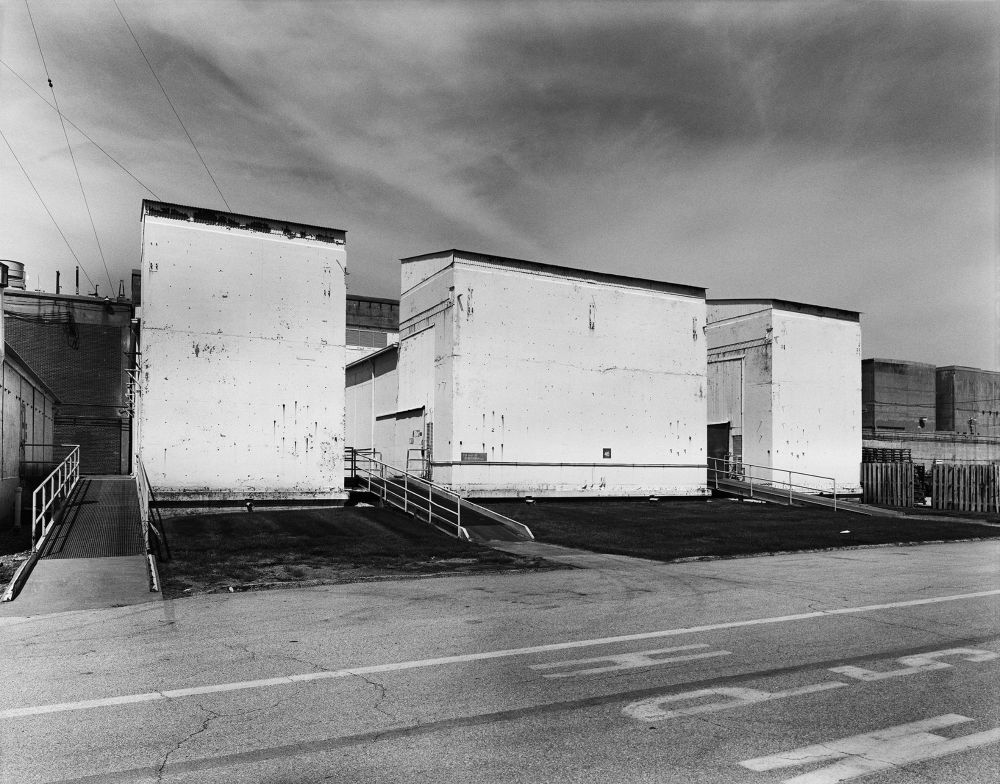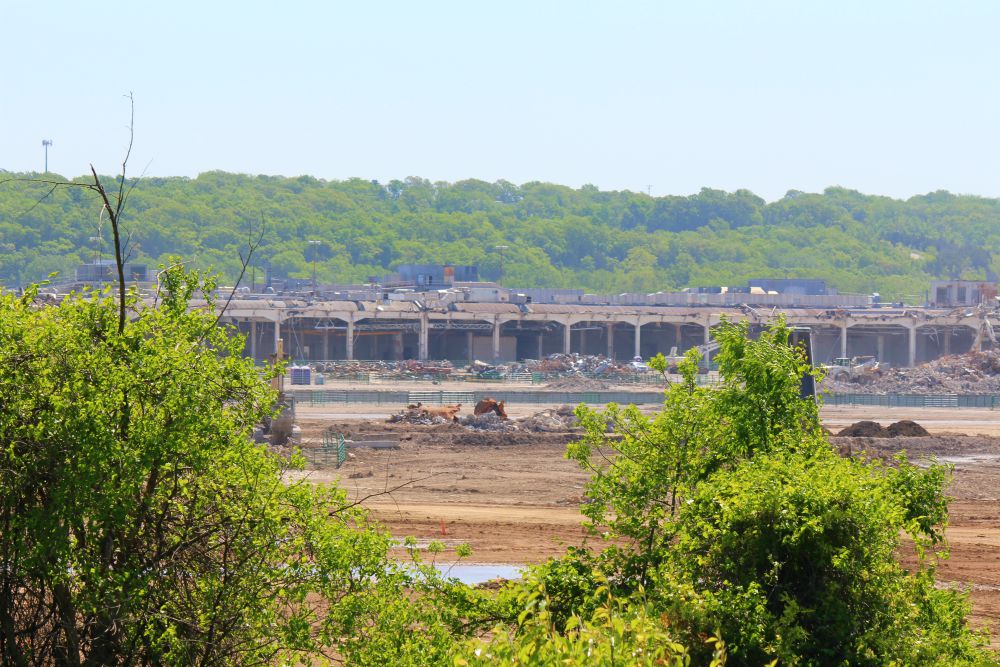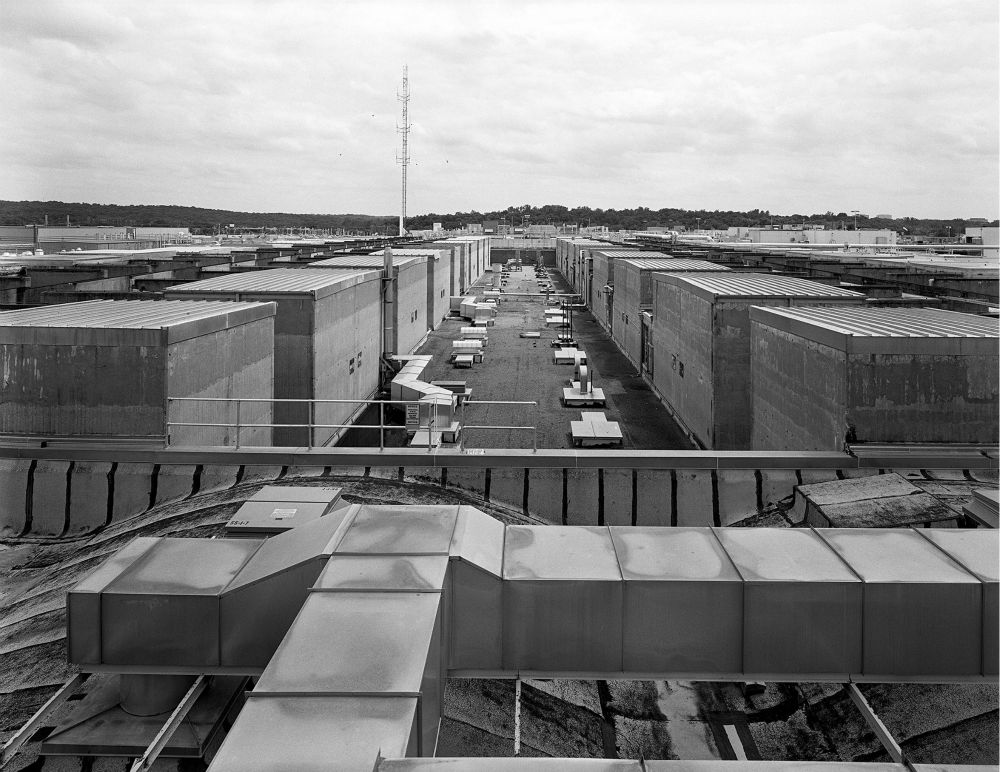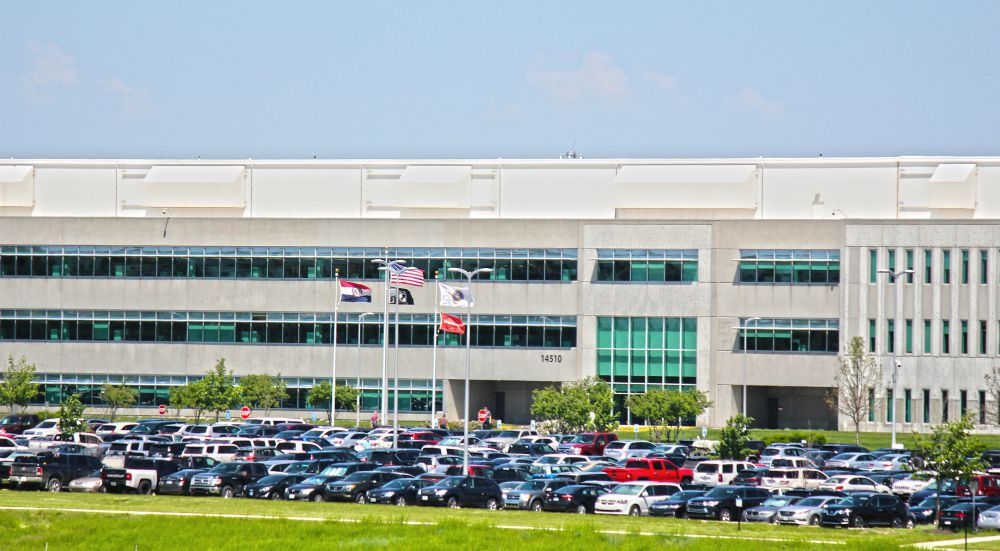Part 2 of NCR’s look at the toxic legacy of one nuclear weapons plant
BY CLAIRE SCHAEFFER-DUFFY | ncronline.org
The Kansas City Plant, pictured May 16, 2019, is under demolition by a private developer. The white bags in the foreground are designed to handle up to 3,000 pounds, or the equivalent of four 55-gallon drums, each of household hazardous waste. (NCR photo/Toni-Ann Ortiz)Editor’s note: As the government invests in the modernization of the U.S. nuclear arsenal, while weakening environmental regulations and federal laws protecting worker safety, National Catholic Reporter looks at the toxic legacy of one shuttered weapons plant in Kansas City, Missouri.
In a three-part series about the Kansas City Plant on Bannister Road and its successor eight miles south, NCR reviews hundreds of pages of government reports and environmental summaries, and interviews more than two dozen sources, including five plant workers and their families, three former federal employees who worked nearby, nuclear industry and government officials, health experts, business sources, state environmental regulators and a former city councilman. This is Part 2. Read Part 1 here.
If the Kansas City Plant was not a “dirty” site, then why were its workers getting sick and dying prematurely? The question haunted television reporter Russ Ptacek. In November 2009, he began investigating the Bannister Federal Complex, a 300-acre property that housed the post-war nuclear components plant as well as various federal offices leased by the General Services Administration (GSA). Ptacek began his inquiry after he was shown a list of nearly 100 sick and dying workers compiled by Barbara Rice, a retired data analyst, who worked for 31 years on the GSA side of the complex.


Rice created her list after she tried to look up some of her colleagues and discovered many had died. “I compiled the information on an Excel spreadsheet and verified it with the … people who contributed” via Facebook, she said.
“[O]varian ‘triple negative’ cancer, which means chemical exposure,” reads one entry. “Goiter and half thyroid removed/hysterectomy because of fast-growing tumors,” reads another. Others list various cancers — bone, liver, tongue, brain. Quite a few note they are “healthy now, but have co-workers who have died/are sick. Worried.”
At the time, Ptacek was reporting for Kansas City’s Channel 41 Action News, an NBC affiliate. His Bannister investigation would later yield an award and new job working for WUSA-9, a CBS-affiliate in Washington, D.C. (Watch videos from that investigative series here.) Early in the project, the Kansas City station created a database on its website where Bannister employees and their families could report illnesses or deaths they believed were linked to exposure of worksite toxins. Within three weeks, there were 117 entries. Sixty reported cancers. Five identified conditions associated with exposure to beryllium, a heavy metal that becomes hazardous in particulate form. Inhaling its dust, fumes or mist can cause breathing disorders or fatal lung diseases.
Many of Ptacek’s exposés focused on offices leased by the GSA. Some, like the Marine Corps Finance Center where Rice had worked, were located within the Kansas City Plant’s Main Manufacturing Building, a massive structure with 2.7 million square feet of space. Here, a thick concrete wall separated GSA offices from the plant’s manufacturing areas. More than 4,300 employees worked throughout the Bannister complex at the time of the investigation, almost 2,500 of them at the Kansas City Plant (KCP). Ptacek discovered that concern over high cancer rates among GSA employees dated back to 2001.
“We were always told the KCP made non-nuclear components for nuclear weapons, but then Russ found documents of accidents. There were many meetings in which people were asking [plant officials], ‘What did you do on the other side of the wall?’ ” Rice said.
During the two-year investigation, Ptacek never found a single smoking gun that explained the illnesses at the Bannister complex. Instead, he uncovered layers of toxicity there that had accumulated over decades. The description of the Kansas City Plant as “non-nuclear” did not mean the plant never worked with radioactive material.
Government summaries of the manufacturing history reveal the Kansas City Plant worked with an array of radioactive materials over several decades. During the 1950s, two operations involved natural uranium. For one assignment, workers cut 10-foot-long rods of the material into slugs — over 1,000 per day — to fuel plutonium production at nuclear weapons facilities in South Carolina and Illinois. In the 1960s, the plant stored substantial quantities of uranium oxide, and some projects used tritium. Through the ’60s and into the ’70s, workers machined depleted uranium and a magnesium thorium alloy. The process generated dust or invisible particulates, increasing the materials’ hazardous effect.
“Uranium and thorium produce radiation, in this case alpha particles, which cause cancer if ingested, inhaled or absorbed through the skin,” said David M. Manuta, a consultant with expertise in chemical industrial processes and radioactive material. He now serves as an expert witness on the workers’ behalf at compensation hearings. He has testified at three in Kansas City.
“The problem is the [KCP] workers were not told, and they were not adequately protected,” Manuta said. “Kansas City was considered non-nuclear. And yet we know otherwise.”

Test cells at the Kansas City Plant, 2013 (Historic American Engineering Record, U.S. Department of the Interior/Richard Welnowski)
The Portsmouth Gaseous Diffusion Plant in Piketon, Ohio, where Manuta formerly worked as senior scientist, has been a source of anxiety for the local community since it was shuttered in 2001. Then, in mid-May, a middle school four miles away closed after traces of enriched uranium, a product the plant once manufactured, were found inside. Manuta said he was not surprised contamination was discovered “off the reservation” but is concerned whether the Department of Energy (DOE) will be open with the community and provide medical services for the children.
Like other nuclear weapons facilities, the Kansas City Plant had its accidents. Plant personnel detected an extensive spill of promethium in 1989 — 15 years after the leak began. Ptacek reported that the low-grade radioactive material was found in the homes and cars of four employees, including Kansas City Plant housekeeper Ivory Mae Thomas, who inadvertently tracked the material offsite. Thomas said she suffered debilitating illnesses after the spill, which forced her to retire early.
The solid waste management units key from the “Corrective Measures Report, Bannister Federal Complex, Kansas City, MO, Draft Final, April 2017” reveals that several areas that were where people worked are still under corrective action. (S.S. Papadopulos & Associates, Inc.)
Radioactive carcinogens were not Bannister’s only hazard. The Kansas City Plant had on-site storage for its industrial waste dating back to the 1940s. In its facility description, the Missouri Department of Natural Resources identified 45 solid waste management units (SWMUs) on the federal property. These units are areas with potential or known releases of toxins that require environmental monitoring. They can vary widely in size from a single tank to a landfill. Among those identified on a map of the Bannister complex are two lagoons, a landfill in the southeast parking lot, several buildings, a small area labeled “classified waste trenches,” and a “depressor pit” in a Kansas City Plant factory shop area where workers once machined radioactive material.
The soil and groundwater contamination map from the “Corrective Measures Report, Bannister Federal Complex, Kansas City, MO, Draft Final, April 2017” shows vast areas of contamination, in proximity to the river and creek. (S.S. Papadopulos & Associates, Inc.)
In other words, the acreage that housed the federal complex on Bannister Road was extensively contaminated. More than 60 years of industrial waste had infiltrated its soil and groundwater with numerous toxins including trichloroethylene (TCE) and polychlorinated biphenyls (PCBs). The EPA considers PCBs to be a probable human carcinogen and TCE as a known one. Ptacek reported on how longtime exposure to their vapors might account for some of the illnesses people were experiencing.
Channel 41 conducted hundreds of interviews and surveyed health reports. After uncovering what Ptacek described as an “alarming number” of pancreatic cancer deaths among Internal Revenue Service employees working at the complex, he investigated the possibility of a cancer cluster. He looked into the consequences of secondary exposure from workers returning home with toxins on their shoes and clothing. He reported when the Environmental Protection Agency (EPA) detected small amounts of beryllium and depleted uranium on the GSA side of the Bannister complex, raising concerns about contaminants migrating throughout the site.
“The problem we had at the KCP, no doubt, is the chemicals, and the way we handled them,” said Maurice Copeland who worked at the plant for more than 30 years as a machinist and supervisor. Copeland is sure there were times when he inadvertently handed his workers “poison.” He said he can remember when beryllium “was stored in every department. People could come through there. They shouldn’t have done that. Anybody could handle it.”

The Kansas City Plant’s Main Manufacturing Building, pictured May 16, 2019, is under demolition by a private developer. According to the Library of Congress, it was approximately 3 million square feet and constructed in less than nine months, and it “demonstrated the utility and economy of [architect Albert] Kahn’s ‘Warspeed’ concept and concrete arches.” (NCR photo/Toni-Ann Ortiz)
The issue of secondary exposure is why Wayne Knox, a retired operational health physicist who worked in several DOE facilities, thinks the estimate of 30,000 as the death toll for nuclear workers nationwide is way too low. “It was a hell of a lot more than that, if you look at exposure to families. In the city of Chicago alone, there were 17 facilities processing beryllium. [The energy department] gave contracts to a lot of people,” he said.
Ptacek’s scrutiny galvanized Bannister employees seeking compensation. It also prompted defensive reassurances from GSA and Kansas City Plant officials about Bannister’s safety. Political leaders called for independent investigations. There were numerous public meetings. The job generator of yesteryear was denounced as a “dump.” Then-Sen. Christopher “Kit” Bond (R-MO) ordered the inspector general of the GSA to conduct a probe. The EPA was brought in to look for toxins in Buildings 50 and 52, then later tasked to supervise a cleanup. At the GSA’s request, the Centers for Disease Control and Prevention (CDC) launched a health hazard survey. Rice wept upon learning of the EPA investigation, anticipating it would provide answers to why her colleagues had gotten so sick.
The multiple probes done in 2010 and 2011 yielded confounding results. Some supported employees’ claims of hazardous worksite exposure. Others concluded the federal complex posed no health threat.
While the CDC health survey identified pathways of airflow between the Kansas City Plant and GSA offices and confirmed shared ventilation systems — something GSA workers had worried about and officials denied — it concluded there was no cancer cluster at Bannister.
Meanwhile, the number of sick and dead workers on the Channel 41 news database kept climbing. By February 2012, it listed well over 400 names.

Roof view of Kansas City Plant’s Main Manufacturing Building, 2013 (Historic American Engineering Record, U.S. Department of the Interior/Richard Welnowski)
Chasing compensation for hazardous jobs
Nuclear workers can face a Sisyphean task when trying to link their illnesses to worksite toxins. While the government’s compensation program covers conditions related to beryllium exposure and radiation-induced cancers, proving the latter can be hard because of the disease’s prevalence. Cancer is the second leading cause of death in the U.S., but carcinogens can take years to wreak havoc in a body. The cancer that killed a middle-aged machinist may have been triggered by exposure to radioactive material. Or cigarettes smoked on break. Or just genes.
The CDC’s Dr. Elena Page said as much during a June 2010 meeting with Bannister workers. Given the overall health of the population and the tens of thousands of employees who had worked at the complex through the decades, the cancer rate was typical for any small town in the U.S., she told them.
“I get that,” said Rice, “but what if everyone in that town who got sick lived on the same street? Wouldn’t that be unusual?”
The Department of Labor oversees the nuclear workers’ compensation program. The CDC assists on the cancer claims, relying on site profiles compiled by the National Institute of Occupational Safety and Health. The purpose of these highly technical reports, which are based on historical documents and worker interviews, is to determine what radioactive materials or other toxins were used at a specific nuclear weapons production site and whether workers were adequately protected.
But compiling data on a decades-old nuclear weapons facility is like assembling a jigsaw puzzle in which pieces are missing or deliberately concealed. Needed information is often unavailable, classified or erroneously interpreted. Many Cold War legacy sites, like the Kansas City Plant, had multiple contractors whose knowledge and practice of industrial hygiene varied through the years. Required to sign non-disclosure agreements, workers sometimes remained tight-lipped about classified assignments. Censorship is also evident in the site profiles.
A 2005 report about the Kansas City Plant notes that information concerning its early history of nuclear weapons assembly “involves classified information; therefore, a clear description of events at that time is not publicly available.”
These gaps in data make it difficult to know completely a plant’s production history and its effects on humans and the environment. Revelations about what was actually done at the site came out gradually. The 2017 site profile of the plant provided a significantly more extensive description of operations involving radioactive material than the 2005 report had.
That is not unusual, said CDC spokesperson Christine Spring. In an email to NCR, Spring wrote that technical contractors review the site profiles and “this leads to additional research to resolve their review findings.” The lengthy process meant some sick workers at the plant waited 12 years for information that could facilitate their compensation.
When Ptacek began his investigation, Honeywell identified 700 known toxins on its Site Exposure Matrix, a document workers must refer to when claiming exposure to a hazardous substance. By the investigation’s end in 2012, the list numbered more than 900. Today it is over 2,000.
An old plant gets a new home
In June 2010, Kansas City officials signed a $1.2 billion 20-year lease agreement to create a new site for the Kansas City Plant on Botts Road and Missouri 150 highway, 8 miles south of the Bannister complex. Negotiations for the purchase of the Kansas City National Security Campus began several years before the Ptacek investigation. Despite the public furor over lethal contaminants at the old site, Kansas City developers had vied with Albuquerque, New Mexico, to keep Honeywell’s nuclear weapons components facility in the region.
“To lose 2,500 good paying jobs would have put a huge hole in our local economy. We wanted to keep those jobs here,” said former City Councilman John Sharp.
The very same politicians, who had railed about the hazardous hulk on Bannister Road, were out in full force at the groundbreaking on Botts Road on August 22, 2014.

Kansas City National Security Campus, May 2019 (NCR photo/Toni-Ann Ortiz)
Thomas D’Agostino, then undersecretary for Nuclear Security and administrator of the National Nuclear Security Administration, told the crowd gathered that day that Honeywell’s move to south Kansas City represented his agency’s desire to transform an outdated, Cold War nuclear complex into a leaner, greener 21st-century national security enterprise.
“It’s about getting out of old, inefficient facilities and getting into modern, clean, smaller facilities,” he said.
Kansas City’s Planned Industrial Expansion Authority nominally owns the $687 million campus. That ownership will eventually revert to an affiliate of Corporate and Governmental Asset (CGA) Capital, the firm that structured the complex financing for the property’s purchase. Here is where the military industrial complex gets “complex.” W. Kyle Gore, managing director and principal at CGA Capital, explains it this way: Kansas City’s development authority currently leases the property to project owner CGA, who subleases to an affiliate of the developer, CenterPoint Properties, which subleases to the government for use by the National Nuclear Security Administration.
“The multi-tier structure [is] designed to isolate certain construction and development risks, and allow institutional investors to provide capital without those investors being [responsible] for or exposed to operating risks and requirements,” Gore wrote in an email to NCR.
The purchase arrangement meant Kansas City could become host to the world’s first privately owned nuclear weapons company, reported Mother Jones. Local activists unsuccessfully sought to block the new plant’s construction with a municipal ordinance banning nuclear weapons production within city limits. Kansas City planners clearly wanted otherwise. In the complex calculus for keeping the plant local, the city’s development authority granted bond subsidies and tax abatement for 25 years in exchange for high-paying jobs, the renewal of a blighted area, and annual payments of $5.2 million in lieu of taxes to the city.
Prior to the Kansas City Plant’s arrival, the trash-laden soybean field on Botts Road was annually bringing in around $1,000 in property taxes, “chump change,” Sharp said. “This was a double win. It not only kept the jobs in Kansas City, it generated significant revenue for the tax jurisdiction.”
At 1.5 million square feet, the Botts Road facility consists of manufacturing, laboratory and office and warehouse space. It is half the size of the old Kansas City Plant, consumes 50 percent less energy, and is one of the first Leadership in Energy and Environmental Design “Gold” manufacturing campuses, according to the DOE. All that downsizing, the agency reported, saves the federal government $100 million annually. Savings could be short-lived. The Government Accounting Office reported in April the new facility will expand by a third in the next five years. Its aggressively growing work force is projected to be at 5,000 by this August.
The cost benefits of the new facility are of little consolation for Barbara Rice, who spends much of her time these days caring for her seriously ill husband. Like herself, he too worked on the GSA side of the Bannister complex. Rice believes her husband’s illness, along with her own (she has Graves disease), are due to their exposure to toxins coming from the Kansas City Plant. Because the Rices did not work at the nuclear facility, they are ineligible for the government’s compensation program for nuclear workers. Rice said she was never interested in the money anyway.
“I just wanted to know what they did over there that made us so sick. They did a plethora of stuff. They did a bunch of stuff that we’ll never know.”
More details would emerge with the sale of the contaminated federal property to a private developer.
[Claire Schaeffer-Duffy, a freelance writer, lives and works at the Sts. Francis and Therese Catholic Worker Community in Worcester, Massachusetts. She and her husband, Scott, co-founded the community in 1987. She has been contributing to National Catholic Reporter since 1999.]
Coming Friday, Part 3: Redemption of a brownfield … and the cost to a community
